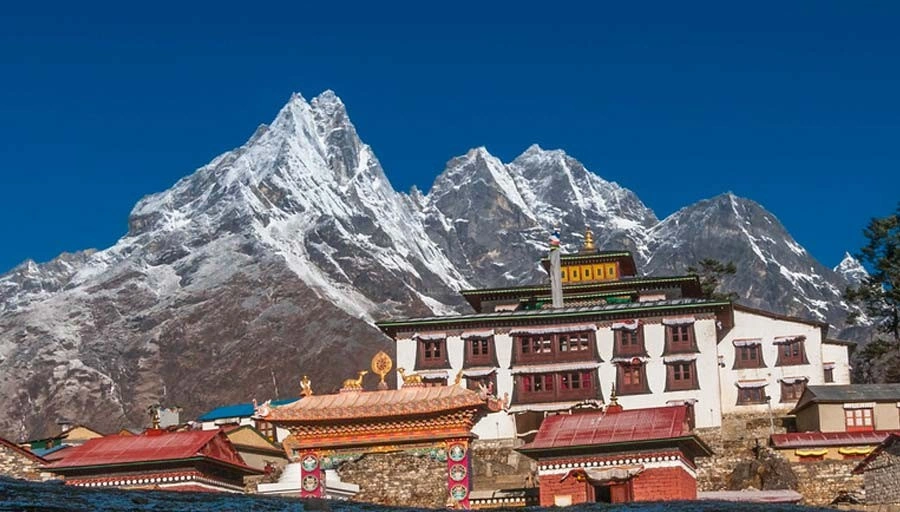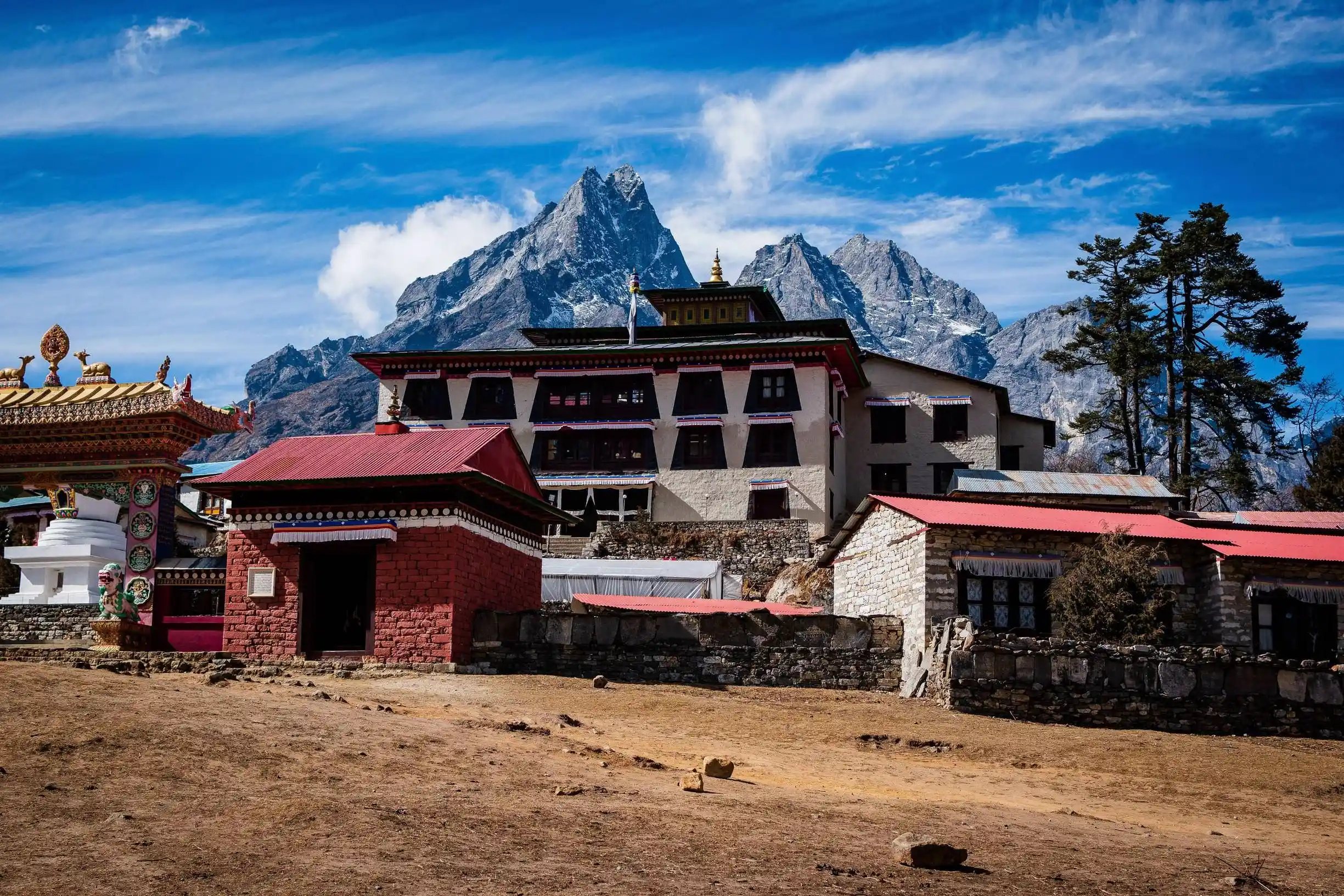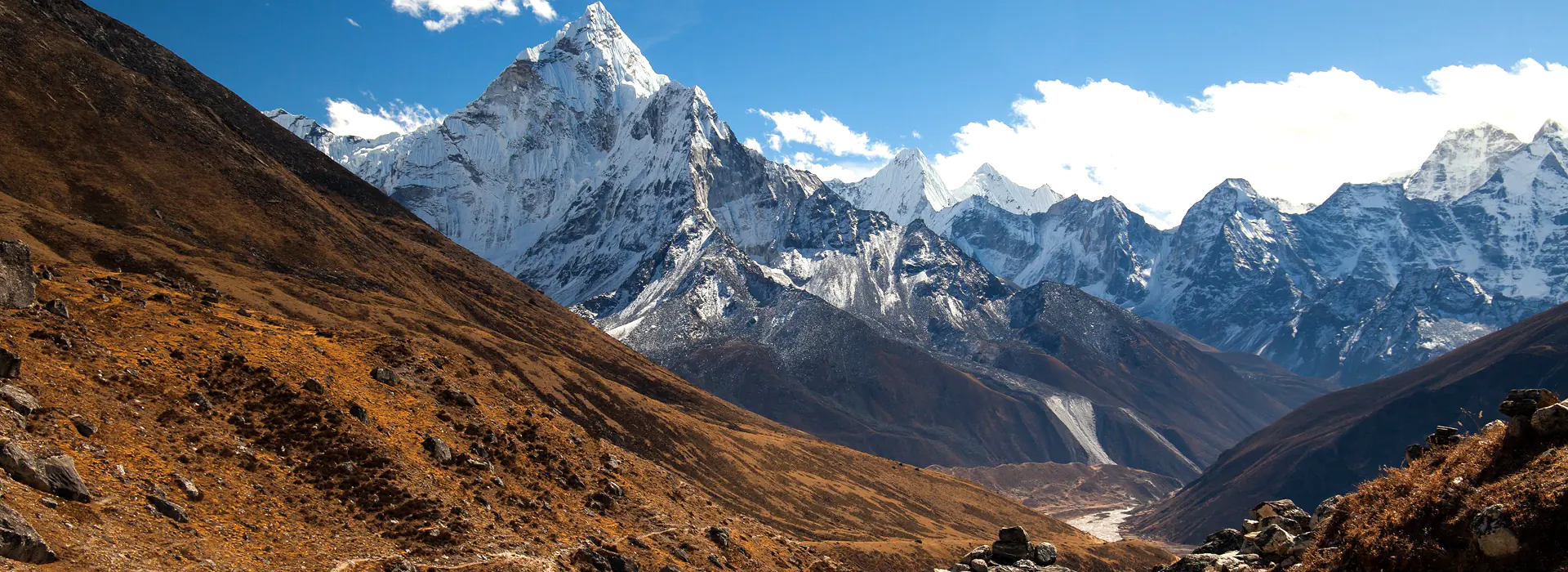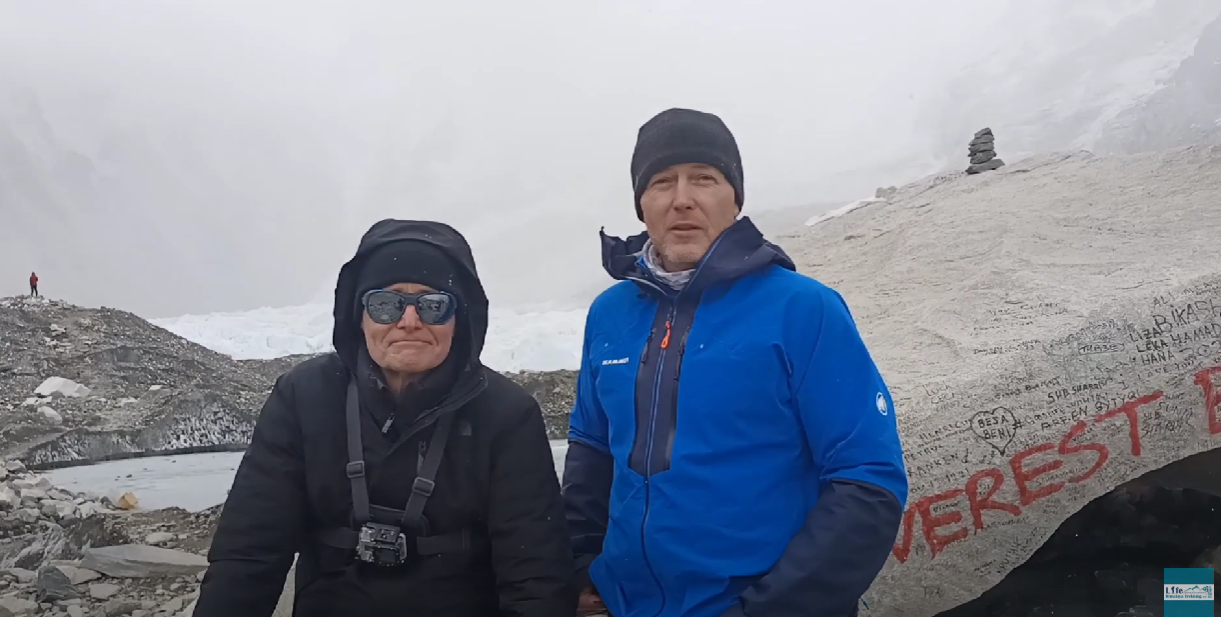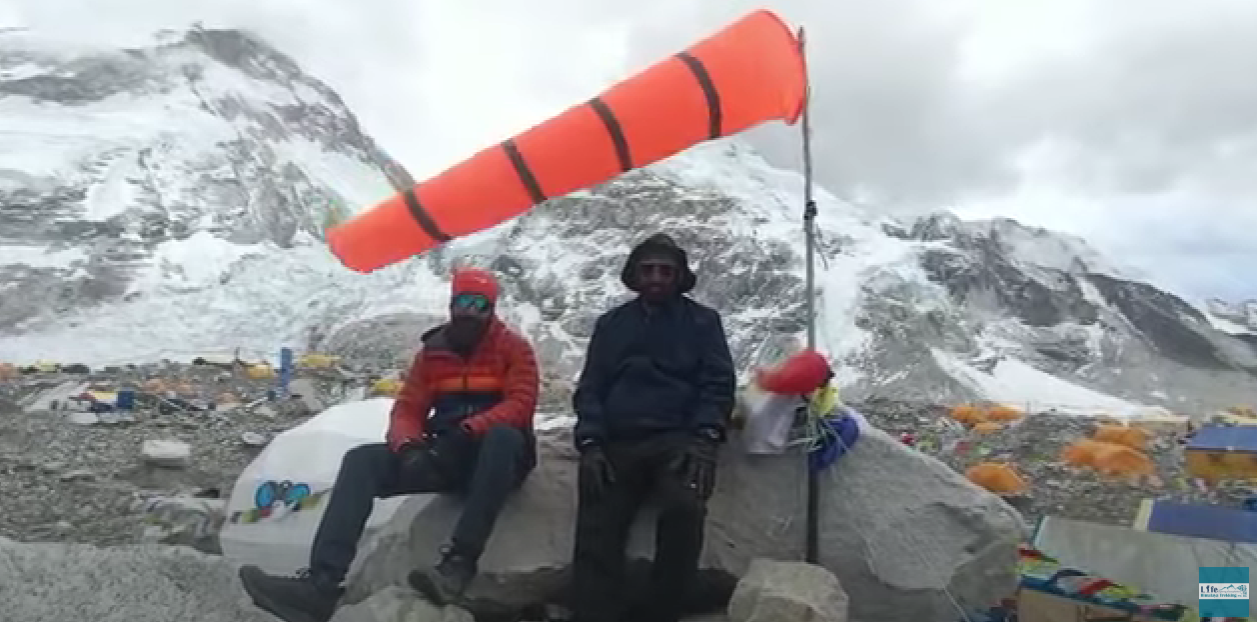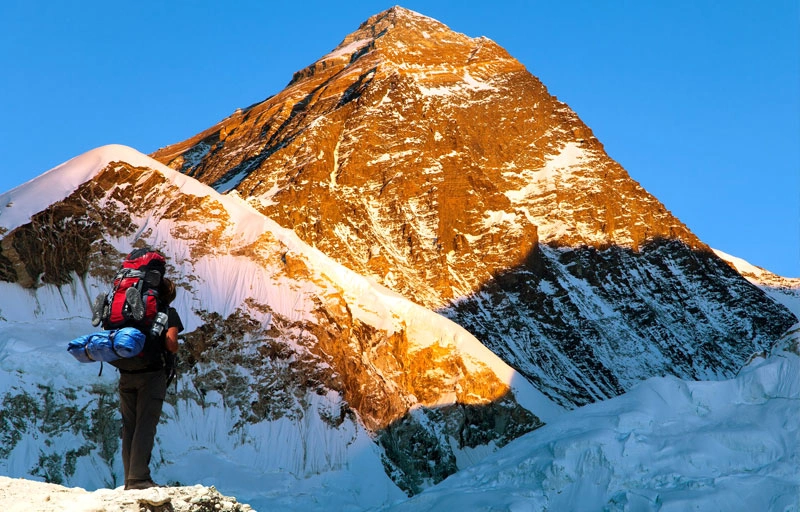Max. Altitude
6,856m
Best Season
Mar-May & Sep-Dec
Activity
Mountain Expedition
Start / End Point
Kathmandu / Kathmandu
Overview of Amadablam Expedition
Have you ever envisioned yourself conquering a 6000 m summit in the Himalaya? What if we tell you, with Life Himalaya Trekking, you can conquer not just one but two breathtaking 6000 m peaks in a single expedition? If this sounds exciting, then be a part of our Ama Dablam expedition today.
This mountain expedition will lead you to the Everest region, where we will aim to summit the enchanting Island Peak (6165 m) and the legendary Ama Dablam (6812 m) in one go.
Most of the expeditions will only allow you to ascend one of these peaks. But through our Ama Dablam expedition, we offer you the splendid chance to face Ama Dablam after acclimatizing on Island Peak first.
The Ama Dablam peak stands just 20 km farther from Everest within the barren grounds of the Sagarmatha National Park. It may not be the tallest mountain, but its mesmerizing beauty and rich symbolism have earned a profound respect from climbers all over the world.
Using the southwest ridge, the team of Mike Gill, Barry Bishop, Mike Ward, and Wally Romanes successfully ascended the summit in 1961.
On the other hand, Island Peak appears to float amid the enormous features of Lhotse, Baruntse, and Nuptse like a beautiful island. A British team comprising Eric Shipton, Charles Wylie, Charles Evans, Alf Gregory, Tenzing Norgay, and seven Sherpas reached its summit in 1953.
Both the Ama Dablam and Island Summits are remarkable pyramids that offer priceless views of Everest (8848 m), Lhotse (8516 m), Makalu (8485 m), Cho Oyu (8188 m), Baruntse (7162 m), Thamserku (6608 m), Pumori (7161 m), Cholatse (6440 m), and many others.
But this is not all, our Ama Dablam expedition will also navigate you through the various original Sherpa communities where you will be able to meet the locals and see personally their unique Tibetan Buddhist customs and monasteries.
The route of our Ama Dablam expedition with Island Peak climbing adventure will at first follow the Everest Base Camp trail. It will pass through the charming villages of Phakding, Namche, Deboche, Dingboche, and Chhukung.
From Chhukung, you will approach the first peak of our Ama Dablam expedition, the Island Summit. Next, your trek will continue to Pangboche.
Now, our Ama Dablam expedition has reached its final phase, leading you to its base camp. From here, you will progress to the summit higher camps until you make your final ascent. After conquering this peak, the Everest trail will guide you back to Kathmandu.
Remember, though, that the Ama Dablam expedition is a challenging mountaineering adventure which suits only the experienced climbers and mountaineers. It needs technical skills, mental resilience, and exceptional physical fitness.
Phases of our Ama Dablam Expedition
Stage 1: Trekking along the Everest Route
Our Ama Dablam expedition will initially follow the most famous route of the Everest Base Camp, leading you through Namche, Deboche, and Dingboche to Chhukung.
Stage 2: Summit the Island Peak
From Chhukung, your journey will progress to the High Camp of the Island Summit, from where you will launch your final attack to its peak.
Stage 3: Trekking to Ama Dablam Base Camp
After Island Peak, the path from Pangboche will guide you to the base camp located beneath the impressive summit of Ama Dablam.
Stage 4: The Ama Dablam Expedition Begins
From the base camp of Mount Ama Dablam, a series of rotation climbs will occur between Base Camp and other higher camps of I and II. You will then make the final ascent of Ama Dablam, after which your descent will be followed back to the base camp.
Stage 5: Descent to Kathmandu Begins
The route will navigate from the base camp through the Everest villages of Namche and Lukla, bringing you back to Kathmandu.
Why should you go with Life Himalaya Trekking for your Ama Dablam Expedition with Island Peak 32 Days Adventure?
Life Himalaya Trekking is a government-registered, well-regarded, and established travel company operating in Kathmandu for over a decade. Our extensive background in the tourism industry has thus allowed us to develop the itineraries that meet the expectations of all our guests.
Plus, our fantastic team is fully capable of promptly managing any medical, technical, or human issues during climbs. We thus assure you the highest success rate for summitting any peak in Nepal.
For our Ama Dablam expedition, along with our expertise, we also offer you:
- 1:1 guide for each climber during the summit ascent
- Portable oxygen cylinders and masks for higher camps, if necessary
- All climbing gear and camping equipment provided
- A great team of crew and chefs at the higher camps
- Quick and effective Rescue Management Protocols
- No hidden fees, covering nearly all expedition costs
- Comfortable lodging, meals, and travel arrangements
- Customizable itinerary to fit your needs.
Highlights of Amadablam Expedition
- Triumphing the Ama Dablam, the peak known among the climbers for its extraordinary beauty
- Acclimatization climb of the magical Island Peak
- The encircling spellbinding views of Everest, Cho Oyu, Makalu, Lhotse, Pumori, Baruntse, and many more
- A time at Namche and its Everest View Hotel
- Sense of accomplishment after accomplishing two outstanding summits
- An action-filled mountaineering action
- A formidable landing at Lukla
- Colorful attractions of Kathmandu
Amadablam Expedition Itinerary
01
Arrival in Kathmandu Airport and transfer to hotel accommodation in Kathmandu (1350 M/4430 ft)
Today, you will land in the true Himalayan Capital of the world, Kathmandu. Our team will meet you at TIA, and they will take you to your hotel accommodation in the city.
Check in and rest after your long, tiring flight. In the evening, you will meet all your fellow climbers and also our guide. He will present a short briefing on our Ama Dablam expedition.
After this briefing, you all can then bond over a dinner of delicious Nepalese cuisine.
Maximum Altitude
(1350m / 4430ft)
Accomodations
Hotel
Transportation
Airport to Hotel Transport
02
Rest in Kathmandu, expedition briefing, and Preparation
Today, in the morning, we will proceed with our guide to fulfill all the essential formalities and permits required for our Ama Dablam expedition.
We will also attend a short orientation regarding our Ama Dablam expedition with Island Peak climbing at the Department of Tourism, after which our day will be free to check our gear and purchase or rent necessary supplies.
We will also explore the Kathmandu metropolis a little and see its significant monuments, such as Swayambhunath and Boudhanath.
NB
We encourage you to go to bed early, as we may need to depart around 2 AM from Kathmandu for Ramechhap to reach Lukla. This is due to the fact that during the Fall and Spring seasons, direct flights to Lukla are frequently redirected to this airport instead of TIA. Life Himalayan Trekking will offer you a private 4-wheel vehicle for the Ramechhap transfer.
Maximum Altitude
(1350m / 4430ft)
Meals
Breakfast
Accomodations
Hotel
03
Fly from Kathmandu or Ramechhap to Lukla and Trek to Phakding
In the very early morning, we will take the most extraordinary and scenic mountain flight to Lukla. While Gaurishankar, Everest, and Kanchenjunga will tower over us all around during the flight, as soon as we land, Kongde Ri will already be present to add more spice.
Here, we will have our meeting with the porters and guides who will take care of all our needs and safety. Then, continuing the thrill, we will take a short downhill trek to Phakding, traversing the Dudh Koshi Valley through its quaint little villages of Chheplung, Chaurikharka, Thadokoshi, and Ghat.
Maximum Altitude
2,860 m
Meals
Breakfast, Lunch, Dinner
Trek Duration
3-4 hrs trek
Accomodations
Lodge
Transportation
45 minutes Flight
04
Trek from Phakding to Namche Bazaar
We will continue our hike following the Dudh Koshi River currents and reach Benkar. From here, our route will uplift towards Monjo, where we will officially enter Sagarmatha National Park.
Then, we will ascend gently through Jorsale towards the iconic landmark of the Hilary Suspension Bridge. After we cross this bridge with Mount Taboche, we will climb steeply uphill along the Top Danda slope to reach Namche, where we will have our first closer view of Everest.
Maximum Altitude
3440m/11286ft,
Meals
Breakfast, Lunch, Dinner
Trek Duration
6-7 hrs trek
Accomodations
Lodge
05
Acclimatization Day at Namche Bazaar with optional hike to Everest View Hotel
This day is dedicated to the proper adaptation to the high Khumbu dry air. Namche is a good spot to rest and look around, but we can take the remarkable opportunity to hike up to the Japanese-made highest luxury hotel on the planet, Everest View, high above the Syangboche cliff.
Once we are down at its terrace for a nice breakfast or lunch, we will be encircled by an extraordinary amphitheater of Nuptse, Lhotse, Everest, Thamserku, Kongde Ri, Taboche, and, of course, Ama Dablam will also be visible.
On our return, we can trek down through Khumjung Village and see the Yeti skull kept in its monastery.
Maximum Altitude
3800m/12487ft,
Meals
Breakfast, Lunch, Dinner
Trek Duration
3-4 hours Trek
Accomodations
Lodge
06
Trek from Namche Bazaar to Deboche
As we leave Namche following the route that will lead us upward to Deboche, we will pass through the beautiful settlements of Kyanjuma and Sanasa.
The route will then run along the stony slope of the Phungi Thenga (3250 m) from where the iconic Tengboche monastery is two hours’ ascent farther.
Once at Tengboche, Ama Dablam will show more clearly its beautiful features, proving why it is considered the most stunning Himalayan Summit in the world. From here, we will make a small downhill descent towards Imja Khola.
The hemp bridge will lead us across from where we will take the path that will elevate to Deboche Village.
Maximum Altitude
3,760 m
Meals
Breakfast, Lunch, Dinner
Trek Duration
6-7 hours Trek
Accomodations
Lodge
07
Trek from Deboche to Dingboche
Leaving from Deboche, we will start resuming our trek along the now slightly desolate landscape. Around a 200 m steep stretch will carry us upward to the Upper Pangboche (3900 m), where stands the timeless monastery said to have housed the authentic Yeti skull one time.
Our ascending trail will be lined by more and more sacred yet very beautiful Mani Walls and prayer flags. We will keep on proceeding up through Orsho, Shomare, and Tsuro Wog before we end our today’s journey in Dingboche.
Welcome to the heavenly playground of Lhotse, Thamserku, Ama Dablam, Nuptse, Taboche, and Cholatse.
Maximum Altitude
4,410 m
Meals
Breakfast, Lunch, Dinner
Trek Duration
5-6 hours Trek
Accomodations
Lodge
08
Trek from Dingboche to Chhukung
Instead of staying in Dingboche, we will engage in a short acclimatization hike towards Chhukung Village. The village lies in the calm Imja Khola Valley, and the route to this village runs alongside the magical, enormous walls of the Lhotse, Ama Dablam, and Nuptse peaks.
The dramatic path consists of rocky outcrops and several small icy streams, so we have to be extra vigilant. After merely ascending for around 2 to 3 hours, we will arrive at Chhukung, beautifully surrounded by the huge pyramidal structures of Makalu, Kongde Ri, Karyolung, Cholatse, Taboche, Numbur, Lhotse, and Island Peaks.
If you are not too tired, you can also progress further to ascend the rocky slopes of 5546 m high Chhukung Ri. However, we suggest you rest and only take short, restful walks in the village.
Maximum Altitude
4,730 m
Meals
Breakfast, Lunch, Dinner
Trek Duration
2-3 hours trek
Accomodations
Lodge
09
Trek from Chhukung to High Camp of Island Peak
As a further preparation for our Ama Dablam expedition, we will now set out to conquer the Island or Imja Tse Summit. With this aim in mind, today we will reach the High Camp of the Island Summit.
The route after Chhukung will head south along the rugged terrain for a while. Then, heading east, we will ascend the icy glacial landscape of the Imja Glacier and then the Lhotse Glacier.
Soon enough, we will be standing just beneath the massive southwest wall of the Imja Tse Peak. This location acts as the base camp of this peak, but we will advance upward for around 300 steep terrain till we are at the High Camp of the summit.
Here, our team of Sherpas will establish tents for our overnight stay. We must retire early as we will be making our ascent of Island Peak very early at around 2 AM in the morning.
Maximum Altitude
5,550 m
Meals
Breakfast, Lunch, Dinner
Trek Duration
5-6 hours Trek
Accomodations
Lodge
10
Ascend the Island Peak, 6165 m, and trek down to Chhukung
Early wakening at midnight, followed by a light breakfast, we will don our attire and gear and set forth to conquer the Island Summit. From High Camp, the route will bend along the icy and rocky surfaces.
We will keep on progressing up for around three hours, after which we will reach the glacier wall. Here, we will put on our mountaineering gear and use a ladder to traverse the crevasses.
An ice axe may have to be used occasionally, along with a rope, which our guide will instruct us on. As we stand around 200 m beneath the summit, we will have to seek the help of a fixed rope and a jumar to traverse the challenge of a 45-degree steep slope.
Finally, the summit of Island Peak is ready to embrace us with the overwhelming views of Thamserku, Lhotse, Makalu, Baruntse, Ama Dablam, Pumori, Cholatse, and Mother Everest.
A brief photo session will be followed after which we will be back at the High Camp for warm drink and meal. Then, we will descend back to Chhukung for the overnight stay.
Maximum Altitude
6,165 m
Meals
Breakfast, Lunch, Dinner
Trek Duration
10-12 hours trek
Accomodations
Lodge
11
Trek from Chhukung to Pangboche
Today, we will descend towards Pangboche, which will be our final village settlement before we commence our Ama Dablam expedition.
From Chhukung, we will bypass the villages of Dingboche, Orsho, and Shomare to reach Pangboche. A little exploration of its tiny yet time-steeped monastery is worth a while.
Maximum Altitude
3,900 m
Meals
Breakfast, Lunch, Dinner
Trek Duration
5-6 hours Trek
Accomodations
Lodge
12
Trek from Pangboche to Ama Dablam Base Camp
Today marks the beginning of our real challenge of the Ama Dablam expedition. From Pangboche, we will momentarily follow the narrow route of the Everest Base Camp.
Then, we will change our direction and traverse the Imja Khola. We will then ascend sharply along the lonely, rugged terrain till we arrive at the moraine wall of the glacier.
This is the spot for setting up our Base Camp of Ama Dablam Summit. We will pitch our tents and then check out the area for a while.
Maximum Altitude
4,600 m
Meals
Breakfast, Lunch, Dinner
Trek Duration
5-6 hours Trek
Accomodations
Tented Camp
Transportation
45 minutes Flight
13
Rest at the Ama Dablam Base Camp
We will spend one extra day at the Ama Dablam Base Camp, where our Sherpa crew will hold a puja ceremony to receive permission for the summit climb from their deities and ensure our safety and success.
Afterward, we can engage in a technical rock wall climbing session with our guide, further enhancing our mountaineering skills that will be essential for conquering the Ama Dablam Summit.
Meals
Breakfast, Lunch & Dinner
Accomodations
Tented Camp
14-27
Mountain action to conquer Ama Dablam and return to Ama Dablam Base Camp
These are the days set aside for mountaineering and triumphing on the Ama Dablam Summit. After the base camp of the summit, we will create two to three intermediate or higher camps to acclimatize and wait for the perfect weather window to attack the summit.
We will traverse the routes to Camp I and Camp II, spend nights there, and descend to the base camp. This rotation plan will ensure our further acclimatization before the final stage of our Ama Dablam expedition.
The final stage of the expedition will largely depend on the weather and also on the physical health of the climber. So, we cannot follow the exact details as we had planned.
Our lead mountaineering guide will make the decision as appropriate. However, we have several reserve days, so each climber will have sufficient alternate days to attack the summit.
However, remember that by the evening of day 27 of our Ama Dablam expedition, we must be at the base camp of the summit.
Our route plan to the Ama Dablam Summit
Ascend from Ama Dablam Base Camp to Camp I, 5700 m, 6 to 7 hours
This route between the base camp to Camp I of the Ama Dablam Summit will be the longest one in our entire Ama Dablam expedition. By the end of the day, we will gain 1100 m in altitude, which can be quite demanding.
Yet, the route is pretty simple, beautiful, and non-technical that traverses the rocky meadow, avoiding the glacial path. En route, Numbur, Mount Everest, Cho Oyu, and Lhotse will keep on spreading their splendor.
As we stand at the final stretch to reach Camp I, the route will take a bit of a demanding turn as we will need to navigate several rock steps and boulders. However, it is completely manageable without using ropes.
Ascend from Camp I to Camp II, 6000 m, 3 to 4 hours
The route that we will be traversing to Camp II from Camp I will be very short yet very technical and most demanding. Today, the elevation gain will be only around 300 m, but this is where the real thrill exists.
Progressing from Camp I, we will step into the glacial terrain where we will ascend over the snowy, rocky granite ridge, facing some hazardous traverses in between.
Then, soon enough, we will be in front of the 5960 m high Yellow Tower, the most challenging segment of the Ama Dablam expedition. This section is graded above 5 because we will have to climb over the exposed walls with the help of fixed ropes and a jumar.
Once through, we will be in the small Camp II of the Ama Dablam space with somewhat confined space.
Ascend from Camp II to Camp III, 6400 m, 3 to 5 hours
Between Camp II and Camp III, we will have to tackle the sharp steep 400 m altitude, which seems short and simple but is quite technical. However, this route will be less challenging than the one that we have faced before between Camp I and Camp II.
After Camp II, the snowy trail will be steep and more exposed, which will ascend us over the ridge that inclines at 60 degrees. Here, we will find the Grey Tower, from which the route continues to the knife-edge ridge of the Mushroom Tower (6250 m).
After this tower, we will have a 600 m sharp drop, from where we will continue our climb towards Camp III. This camp is a land of broad snow where we will be sleeping before we assault the Ama Dablam Summit.
Climb the Ama Dablam Summit, 6812 m, and trek back to Ama Dablam Base Camp, 10 to 12 hours
We will set forth on our summit journey to Ama Dablam from Camp III at around 2 to 3 AM. The climb will be less demanding, which will take place mainly over the snowy slopes and walls of the summit itself that are inclined at 55 to 65 degrees.
Using our gear, probably ropes, a jumar, and ice axes, we will reach the peak within 4 hours. As we wave our flags with pride, we can also look around some of the tallest peaks on the planet: Everest, followed by Makalu, Chamlang, Cho Oyu, Thamserku, Lhotse, Kangtega, Pumori, Nuptse, Island, and Baruntse.
Based on the climate and wind speed, we will spend some time at this beautiful summit, after which we will descend to Camp III first for our hot beverage and meal.
Then, following the same technical trail, we will make our return to the Ama Dablam Base Camp for the night.
NOTE
Please understand that we will not set up Camp III compulsorily; it will be an optional setup based on the weather and the physical well-being of the climbers.
Our guide leader will decide whether to set up Camp III and start the Summit attempt from there. There will be no additional costs for setting up Camp III if needed.
Also, please know that the plan that we have stated here can be changed based on the climate and health of the climbers. Our climbing guide leader has the authority to change or adjust the climbing plan accordingly.
Maximum Altitude
6,812 m
Meals
Breakfast, Lunch & Dinner
Accomodations
Ama Dablam
Transportation
Transfer to Airport
28
Trek from Ama Dablam Base Camp to Namche Bazaar
Our Ama Dablam expedition with Island peak 32 days adventure is now slowly approaching its end. We will leave our base camp and then start to climb down, leaving behind the Himalayan behemoths.
We will bypass Pangboche and Tengboche until we are inside the Dudh Koshi Valley again, where warmer air is welcome on our skin. Namche Bazaar will soon be reached, where the warmth and comfort will certainly be very encouraging.
Maximum Altitude
3,440 m
Meals
Breakfast, Lunch & Dinner
Trek Duration
6-7 hours Trek
Accomodations
Lodge
29
Trek from Namche Bazaar to Lukla
Maximum Altitude
2,860 m
Meals
Breakfast, Lunch & Dinner
Trek Duration
6-7 hours Trek
Accomodations
Lodge
03
Flight to Ramechhap or Kathmandu
A very early morning Himalayan flight will transport us either to TIA or Ramechhap. If our arrival takes place at Ramechhap, then Life Himalaya Trekking’s private 4-wheel vehicle will be at the airport for our transfer to Kathmandu.
Relax, rest, and pamper yourself with a massage or spa as you have rightfully earned this privilege.
Maximum Altitude
1,350m
31
Leisure Day in Kathmandu
You will have a free day today, and we have not planned any activities for you. So you can look around the city and see its monuments on your own, which you may have missed on your earlier day.
If you desire, we can also organize a private guided tour for you. In the evening, Life Himalaya Trekking will organize a grand gala dinner for you, celebrating your success in the Ama Dablam expedition.
We will also present you with an achievement certificate for the successful climbs of Island Peak and Ama Dablam.
Meals
Dinner
32
Departure
Today, you will part ways with the beautiful Kathmandu today. With full of memories from your achievement on the Ama Dablam expedition, you will begin the long journey back home. Life Himalaya Trekking will be with you till TIA.
NOTE
If you only like to trek up to the Ama Dablam Base Camp, then we also offer you the Ama Dablam Base Camp trek package, a short yet very comfortable journey up to the foot of the beautiful jewel of the Khumbu.
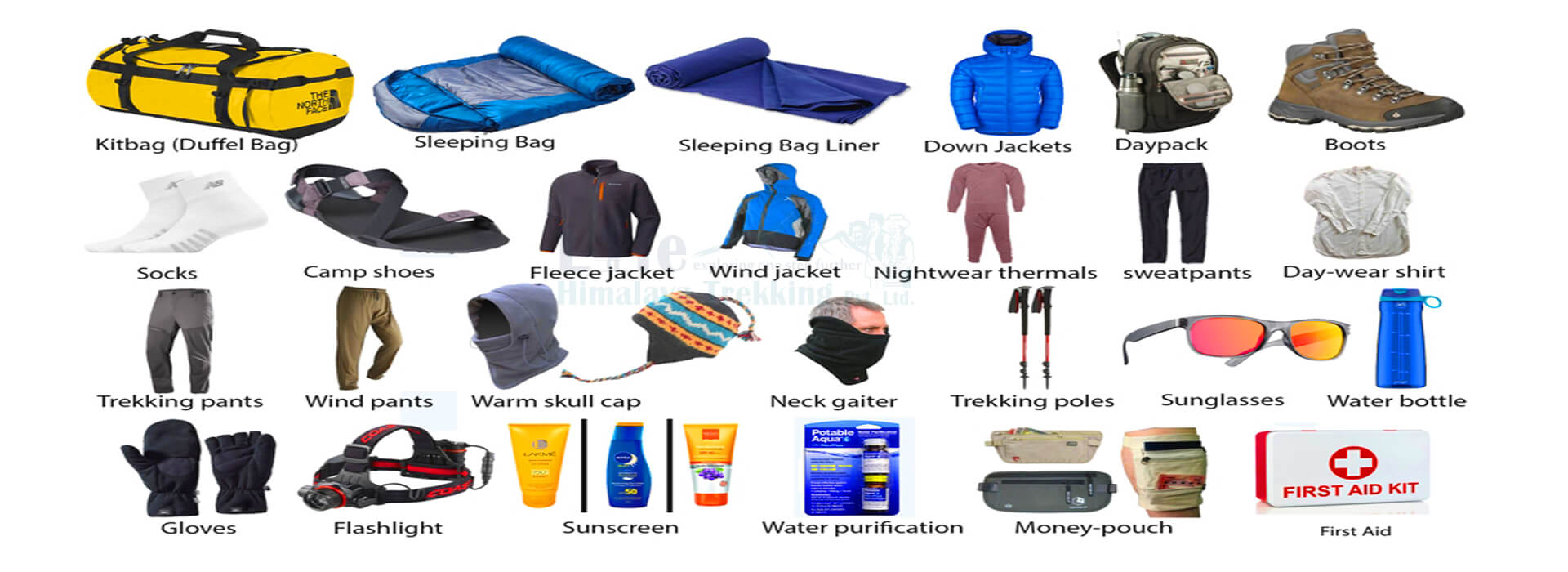

Required Equipments for Trekking in Nepal
- Breathable Underwear
- Sports Bra
- Base Layers
- Trekking Shirts
- Trekking Trousers and Shorts
- Fleece Jacket
- Down jacket (insulated jacket)
- Windcheater (water proof)
- Sun protection Hat
- Headband or Beanie
- Scarf or neckband
- Gloves (inner and outer )
- Hiking Boots
- Trekking Shoes
- Hiking Socks
- Thermal Socks
- Gaiters
- Duffel Bag
- Day pack
- Sleeping Bag
- Trekking poles
- Sunglasses
- Hydration bladder or Water bottle
- Head Lamps
- Batteries
- Personal towel
- Swiss army knife
- Sun lotion
- Medical & first-aid kit
- Woolen socks
- Waterproof jacket
- Lip Guard
- Insulated pants
- Baby wipers
Required Equipments for Climbing in Nepal
- Water bottle
- Batteries and bulbs
- Flashlight
- Personal towel
- Swiss army knife
- Rucksack
- Sun lotion
- Medical & first-aid kit
- Sewing kit
- Polypropylene/wool socks
- Other required equipment
- Sleeping bag
- Down Jacket
- Waterproof jacket
- Trekking shoes/boots
- Camp shoes
- Jumperorpile jacket
- Hiking pants
- Hiking shirts
- Full–sleeves shirt
- T-shirts
- Sun hat
- Gloves
- Woolen hat
- Long underwear
- Goggles or sun glasses
- Gaiters
- Sun block for lips
- Light cotton socks
- Mountain trekking boots
- Woolen socks to wear with boots
- Nylon wind breaker
- Insulated pants
- Nylon wind pants
- Long sleeved cotton/woolen shirts
- Sun hat
- Long cotton hiking shorts
- Fleece/wool for climbing
- Lightweight fleece
- Sleeping pad (karri mat) or thermarest
- Down high altitude sleeping bag
- Down jacket/trousers/vest
- Light cotton athletic socks and wool socks
- Water proof climbing jacket
- Head torch/batteries/bulbs
- Climbing sunglasses
- Lightweight thermal/insulated ski gloves
- Sun screen
- Warm climbing trousers
- Wool long underwear
- Other required equipment
- Climbing boots
- Gaiters
- Ice axe
- Harness
- Crampons
- Karabiners
- Tapes/slings
- Snow bars
- Ice screws
- Rock pegs
- Deadmen
- Crash hat
- Day bag
- Rucksack
- Lip salve
- T-shirts
- Ascenders
- Ascenders
- Kit bag
What's Included
- Roundtrip flights Kathmandu-Lukla and Lukla-Kathmandu
- International and Domestic airport transfers, Pick up and Drop
- 3 Nights hotel accommodation in Kathmandu with breakfast
- Accommodation while trekking in the best mountain lodges
- Tented accommodation in the base camp and all higher camps
- Full board meals (breakfast with tea/coffee, lunch, dinner) during the trek
- As per group size experience, government license holder trek & climbing guide, helpful and friendly strong, porters (1 porter for 2 people) and their food,
- Government Liaison officer with his flight, food, accommodation, equipment, and wages
- Porter service for members’ baggage up to the base camp and return
- Well-trained and friendly base camp staff, cook and support staff
- Insurance, wages, flight, equipment, and allowances for climbing Sherpa and support staff
- Oxygen bottles, masks, and regulator available at base camp in case of emergency
What's Excluded
- Meals not quantified in the ‘Meal Inclusions’ in the itinerary’
- Travel insurance
- International airfare
- Nepal entry visa charge.
- All beverage and others personal expenses.
- Snacks and other personal expenses
- Hot shower during the trek.
Add Ons
Upgrade your Accommodation in Kathmandu
For your Ama Dablam expedition with Island Peak climbing adventure, Life Himalaya Trekking will offer you a twin occupancy room in a well-regarded three-star hotel in the city.
However, we also present you with the option of upgrading your hotel by adding just a few extra bucks. You can upgrade your stay to a more luxurious and elegant four or five-star hotel where you will get not only high-standard utilities but also the highest international hospitality services.
When you book our Ama Dablam expedition, just tell us about your intention of upgrading and leave the rest to us.
Upgrade your Teahouse Accommodation in Everest Villages to Premium Lodges
The Everest trail has now transformed, and today almost all villages now have several premium lodges that offer exceptional services such as hot showers, single rooms with private bath, WiFi, and room heaters.
If you desire, we can accommodate you in one of these premium high-end lodges in Lukla, Phakding, Namche, Deboche, Pangboche, and Dingboche.
All you have to do is add a modest surcharge for this arrangement, and you can imagine the luxury amid the high Himalayas of Nepal.
Upgrade your Lukla Flight with a Helicopter
We understand the Ramechhap redirection to Lukla will be quite a stress. So if you like, you can bypass this deviation by taking a helicopter straight to Lukla.
This will not only save your time but will also allow you to have a few extra hours of rest and sleep, along with the comfort of a more adaptable travel schedule.
Adding an extra sum, you can choose between a private or shared helicopter flight. Please let us know about your upgrade at the time of your booking the Ama Dablam expedition, and we will make all the arrangements.
Amadablam Expedition Trip Information
Best Season for the Ama Dablam Expedition
According to the seasoned climbers, September, October, and November, the autumn months, are seen as the best time for the Ama Dablam expedition with Island peak climbing.
The constant stable climate, the hardening of the snowy trail, and pleasant temperature in the daylight hours present a suitable time in autumn.
The spring in March, April, and May presents the second-best time for this expedition, with an almost empty trail as more climbers are focused on Everest in the spring.
The early winter from December to January also offers a pleasant climb over Ama Dablam and Island Peaks, provided you are equipped with all the essential and right gear.
February (the coldest month) and June, July, and August (summer/monsoon) bring the potential hazards of avalanches, high and skin-piercing winds, thus creating unfavorable weather for the Ama Dablam expedition.
Difficulty Grade of the Ama Dablam Expedition with Island Peak Climbing
The summit of Ama Dablam has the complexity level of TD graded as 5 on the Alpine scale. On the other hand, the Island Summit has a grade of 2B, a Himalayan peak, which presents the PD+ (Peu Difficile Plus) challenge in the alpine scale.
The Ama Dablam Summit is a very complicated and technical peak that consists of the challenge from the Yellow Tower and Mushroom Ridge. Its walls are also inclined at 55 to 65 degrees, making the ascent quite tougher and technical even for experienced mountaineers.
Thus, along with the experience, the Ama Dablam expedition will demand a deliberately planned, extensive preparation and fitness.
The Island Summit is, however, a moderate peak that does not necessitate climbing skills.
As for the overall trekking route of the Ama Dablam expedition, the trail also presents only a medium challenge of profile II level, suiting even beginner hikers.
Notably, the most Demanding and Technical Sections of the Ama Dablam Expedition with Island Peak 32 Days Adventure
The route between Camp I and Camp II
Moving to Camp II of the Ama Dablam Summit from Camp I will be the most technically challenging. En route, the lofty rock structure of Yellow Tower lies, which has a 90-degree steep slope followed by a 600 m sheer drop along the exposed areas.
The difficulty will be added by the fierce wind, snowfall, and very cold extreme temperatures as well.
The route between Camp II and Camp III
The trail linking Camp II and Camp III is the second most demanding section of the Ama Dablam expedition. The knife-like sharp edges of the Grey and Mushroom tower will make the challenge quite daunting.
Ama Dablam Summit and Descent
The Ama Dablam Summit walls are inclined to steep angles of 55 to 65 degrees, while its slopes run along the exposed part, which are sharp, steep, and rocky as well.
The descent, followed by the triumph over the summit, is equally hard, as you will have to trace the same arduous paths between camps, thus demanding your full attention.
Who is the Ama Dablam Expedition suitable for?
If there is any mountain that is made for the true mountaineers, then it is Ama Dablam. The summit offers a very tough climbing adventure that calls for not only experience but also strong determination.
The Ama Dablam Summit is also very technical and needs its climbers to possess skills of ice and rock as well as mixed climbing. The climbers should also have considerable experience with using the gear in the right way when needed.
It is not for nothing that Ama Dablam is called the preparatory ground for the 8000 m+ peaks. Thus, the Ama Dablam expedition is truly meant for experienced mountaineers.
Altitude Sickness/AMS Management
Our excellent team has come up with the best acclimating itinerary for our Ama Dablam expedition that promotes your gradual acclimatization before your final summit push.
We have placed rest and acclimating days in Namche, Dingboche, and at the Base Camp of Ama Dablam, followed by traversing ascents between higher camps.
Additionally, for excellent acclimatization, we have also proposed the climb of the Imja Tse peak first. Despite all these management, some climbers may still experience mild altitude sickness symptoms such as headache, disorientation, appetite and sleep loss, and extremities swelling.
These symptoms are generally short-lived, but if they persist or turn severe, our guide will provide you with oxygen. They will constantly monitor you and determine if a descent is needed.
We additionally recommend Diamox as it will promote quick adaptation to the high elevation. Also, remember to maintain hydration and nutrition during the Ama Dablam expedition.
Preparation for the Ama Dablam Expedition with Island Peak 32 Days Adventure
The Ama Dablam expedition requires not only excellent skill levels but also exceptional physical well-being. So we encourage you to dedicate at least six months of your time in preparation for the Ama Dablam expedition.
Mainly, you should concentrate on improving your strength and cardiovascular endurance. You can start with walking, jogging, cycling, and swimming, then boost yourself with Pilates, squats, pull-ups, push-ups, and sit-ups.
Also, don’t forget to incorporate deep breathing, meditation, and yoga to build mental resilience that will help you when you feel lonely or stressed.
Technical Skills and Training for the Ama Dablam Expedition with Island Peak Climbing
Besides physical training, we also like to encourage you to engage in advanced mountaineering classes so you can develop or polish your technical skills.
For the Ama Dablam expedition, you should have skills in ice and rock climbing or mixed climbing. So it will be beneficial if you familiarize yourself with the multi-pitch climbs rated up to 5.10 a, b, c, and ice climbing skills up to WI-3 or WI-4.
Likewise, you should also be proficient in climbing with an ice axe, abseil independently, and be able to traverse over ladders or along the fixed line ropes using a jumar.
Alternate Approach to Ama Dablam Summit
The southwest ridge of the Ama Dablam is the chosen route for our Ama Dablam expedition, which is the best acclimating and safest route for the climb.
There are also three more approaching routes exist:
- Eastern Ridge: This route is the most technically advanced and was successfully attempted only in 1983
- Lower Ridge: This route will lead you ultimately to the south wall of Ama Dablam and was successfully attempted in 1979
- North Ridge: This route is the alternate route to the southwest ridge and was successfully attempted in 1979
Additionally, you can also consider ascending Lobuche East (6119 m) instead of Island Summit.
Instead of hiking towards Chhukung, you can take the route from Dingbcohe to Lobuche Village and then proceed to the high camp for the summit. Additionally, you can also add a detour to the Everest Base Camp and Kala Patthar.
Other Peaks you can aim for after the Ama Dablam Expedition
Believe us when we say you are now ready to face the intimidating challenges of 8000 m+ peaks after you triumph in the Ama Dablam expedition.
Peaks you can pursue after the Ama Dablam Summit include:
- Manaslu (8163 m),
- Annapurna (8091 m),
- Kanchenjunga (8586 m),
- Dhaulagiri (8167 m)
- Everest (8848 m) and many others around the world
Accommodation, Meals, and Transportation
During our Ama Dablam expedition, we will stay in a twin room of a three-star hotel in Kathmandu. During the trek, we will use the best guesthouses along the Everest route, which are also called the teahouses.
You will get a hot shower, WiFi, and a private bath with complete privacy. These utilities will have to be paid personally in situ.
During the two mountain ascent, Life Himalaya Trekking will supply high-quality two-person mountain tents. You will get individual tents for sleeping, eating, cooking, shower, and toilets. At these camps, you will also have solar batteries for charging your devices.
Regarding meals, breakfast in Kathmandu and full board meals on the trek and ascent are available. Food at the time of ascent will be cooked at the tents by our cook.
In terms of transport, our 4-wheel will be offering you pick up and drop off services to the domestic and international airports, as well as Ramechhap transport.
Your Kathmandu-Lukla-Kathmandu flights will also be looked after by our efficient team.
Travel Insurance
Please know that travel insurance is a mandatory element for our Ama Dablam expedition. With the added safety covering your financial liability on the expedition, the insurance policy is also vital to get the climbing permits for the Island Peak and the Ama Dablam Summit.
Remember that Khumbu is still a remote mountain terrain where easy access is achievable only through a helicopter. In the event of any mishaps on the expedition, it will be the only means for your rescue.
Therefore, for our Ama Dablam expedition with Island peak climbing, get the policy that includes helicopter emergency services for elevations up to 7000 m.
Additionally, also specify the accident and medical coverage as well as financial support for expedition delays, unexpected extended stays, and cancellations.
Permits needed for the Ama Dablam Expedition with Island Peak 32 Days Adventure
Since we will be accomplishing the exciting feat of climbing two 6000 m peaks, we must have the climbing permit for both peaks, which will be issued by the Nepal Mountaineering Association/NMA in Kathmandu.
Climbing Permit Cost for Ama Dablam
- Spring and Autumn Climb: USD 400 per climber
- Winter and Summer Climb: USD 200 per climber
Climbing permit cost for Island Peak
- Spring Climb: USD 250 per climber
- Autumn Climb: USD 125 per climber
- Summer and Winter Climb: USD 70 per climber
Additional Mandatory Permits
With a climbing permit for the two summits, we also need to secure the Sagarmatha National Park permit and the Khumbu Municipality permit for the Ama Dablam expedition.
Life Himalaya Trekking team will see to these permit arrangements while in Kathmandu and Lukla. The pricing for the Sagarmatha National Park permit is NPR 3000 per hiker, and for the Khumbu Municipality permit is NPR 2000 per hiker.
Additional Mandatory Fees
As per the regulations established by the Nepal Government, the Ama Dablam expedition with Island Peak climbing must also appoint the services of a Liaison Officer (LO).
He will monitor the following of the environmental guidelines along with instant communication in times of need. Generally, the costs for the LO are incorporated in the permit fees.
Additionally, a garbage deposit of USD 400 per team for Ama Dablam and USD 500 per team for Island Summit will also be required to encourage climbers to return their garbage and dispose of it correctly.
If you adhere to the rules, you will get the deposit back, and any deductions will be based on the guidelines set by the NMA.
FAQs For Amadablam Expedition
General
What is the Ama Dablam expedition?
It is the high mountaineering expedition guiding you to the summit of not only Ama Dablam but also Island Summit, both located within the remarkable region of Everest.
How challenging is your Ama Dablam expedition with Island Peak 32 days adventure?
The Ama Dablam summit is the grade 5 technical summit, while Island is the PD+ summit of medium challenge.
Is the Ama Dablam Peak very technical?
Yes, the Ama Dablam Summit and its climbing trail starting from Camp I is very technical.
Which part of the Ama Dablam expedition is the toughest?
The route extending between Camp I and Camp II, along with the trail between Camp II and Camp III, is the most technical and demanding.
What summits should I try before attempting the Ama Dablam Summit?
Mera, Lobuche, Pisang, Yala, and Island peaks are excellent choices for you.
What is the starting point for the Ama Dablam expedition with Island Peak Climbing?
The expedition will commence and conclude in Lukla.
When is the best time to participate in the Ama Dablam expedition?
For the best success, the autumn months are best suggested for the Ama Dablam expedition.
What does the total price of your Ama Dablam expedition include?
It will cover almost all your expedition costs, except for personal choices, international airfare, Nepal Visa, personal insurance, personal gear, tips, etc.
How reliable are cellular services and internet on the route to Ama Dablam?
NTC and NCELL offer excellent network throughout the Everest region. Likewise, the Everest Link and AirLink work best for WiFi access.
Will I receive any mountaineering gear from Life Himalaya Trekking for the Ama Dablam expedition?
Definitely, all the necessary mountaineering gear, such as boots, sticks, ropes, ice bars, screws, oxygen bottles, hoses, masks, and regulators, walkie-talkies, satellite phones, first aid kits, and other emergency equipment like Gamow Bags, ice walls, and climbing ladders, will be provided.
What will the cost be for the Ama Dablam expedition with Island Peak 32 Days journey?
We have the package ranging from standard, comfortable, and luxurious. So the cost will be based on the package you select.
How many guides will accompany me during the Ama Dablam ascent?
You will have one guide for each climber during the Ama Dablam ascent.
What will my sleeping arrangements be like during the Ama Dablam expedition?
In addition to hotels and lodges, the Ama Dablam expedition will also involve some overnight camping, and Life Himalaya will provide you with a high-quality two-person box tent.
Should I be cautious about any health problems during the Ama Dablam expedition?
Some digestive problems may happen at first while adjusting to the Nepali menu. Altitude sickness will also be of main concern.
Can I charge my phone at the Higher camps of the Ama Dablam Summit?
Absolutely! There will be solar power available for charging your phones and cameras.
Is it necessary to go over Island Summit before heading to the Ama Dablam peak?
Not at all! You can also opt for the Ama Dablam ascent only.
Is your Ama Dablam expedition itinerary the best travel program?
Definitely! It provides a 100 percent acclimatization opportunity before you tackle the Ama Dablam Summit.
Video Reviews
Tripadvisor Reviews
Google Reviews
Similar Trips
Join us on similar trips in the same region




